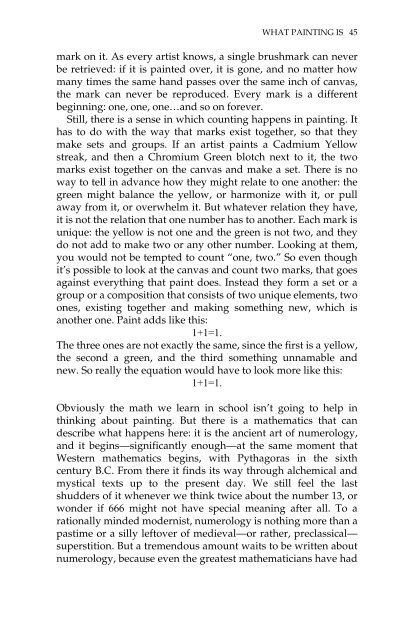What Painting Is: How to Think about Oil Painting ... - Victoria Vesna
What Painting Is: How to Think about Oil Painting ... - Victoria Vesna
What Painting Is: How to Think about Oil Painting ... - Victoria Vesna
You also want an ePaper? Increase the reach of your titles
YUMPU automatically turns print PDFs into web optimized ePapers that Google loves.
WHAT PAINTING IS 45<br />
mark on it. As every artist knows, a single brushmark can never<br />
be retrieved: if it is painted over, it is gone, and no matter how<br />
many times the same hand passes over the same inch of canvas,<br />
the mark can never be reproduced. Every mark is a different<br />
beginning: one, one, one…and so on forever.<br />
Still, there is a sense in which counting happens in painting. It<br />
has <strong>to</strong> do with the way that marks exist <strong>to</strong>gether, so that they<br />
make sets and groups. If an artist paints a Cadmium Yellow<br />
streak, and then a Chromium Green blotch next <strong>to</strong> it, the two<br />
marks exist <strong>to</strong>gether on the canvas and make a set. There is no<br />
way <strong>to</strong> tell in advance how they might relate <strong>to</strong> one another: the<br />
green might balance the yellow, or harmonize with it, or pull<br />
away from it, or overwhelm it. But whatever relation they have,<br />
it is not the relation that one number has <strong>to</strong> another. Each mark is<br />
unique: the yellow is not one and the green is not two, and they<br />
do not add <strong>to</strong> make two or any other number. Looking at them,<br />
you would not be tempted <strong>to</strong> count “one, two.” So even though<br />
it’s possible <strong>to</strong> look at the canvas and count two marks, that goes<br />
against everything that paint does. Instead they form a set or a<br />
group or a composition that consists of two unique elements, two<br />
ones, existing <strong>to</strong>gether and making something new, which is<br />
another one. Paint adds like this:<br />
1+1=1.<br />
The three ones are not exactly the same, since the first is a yellow,<br />
the second a green, and the third something unnamable and<br />
new. So really the equation would have <strong>to</strong> look more like this:<br />
1+1=1.<br />
Obviously the math we learn in school isn’t going <strong>to</strong> help in<br />
thinking <strong>about</strong> painting. But there is a mathematics that can<br />
describe what happens here: it is the ancient art of numerology,<br />
and it begins—significantly enough—at the same moment that<br />
Western mathematics begins, with Pythagoras in the sixth<br />
century B.C. From there it finds its way through alchemical and<br />
mystical texts up <strong>to</strong> the present day. We still feel the last<br />
shudders of it whenever we think twice <strong>about</strong> the number 13, or<br />
wonder if 666 might not have special meaning after all. To a<br />
rationally minded modernist, numerology is nothing more than a<br />
pastime or a silly lef<strong>to</strong>ver of medieval—or rather, preclassical—<br />
superstition. But a tremendous amount waits <strong>to</strong> be written <strong>about</strong><br />
numerology, because even the greatest mathematicians have had


